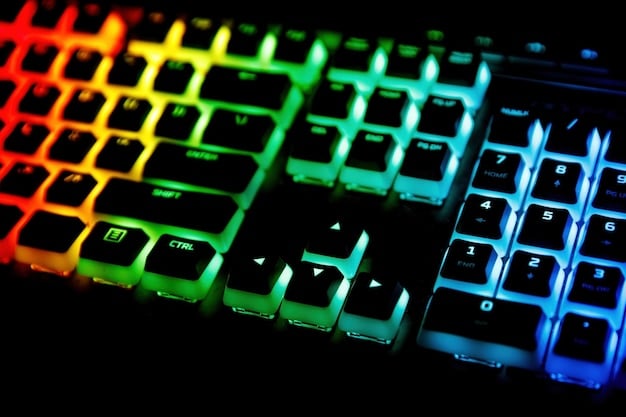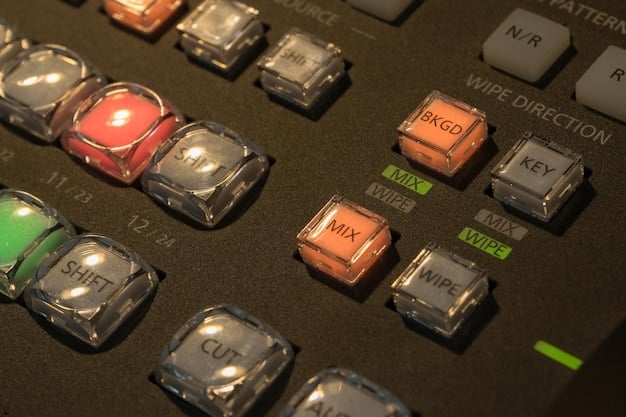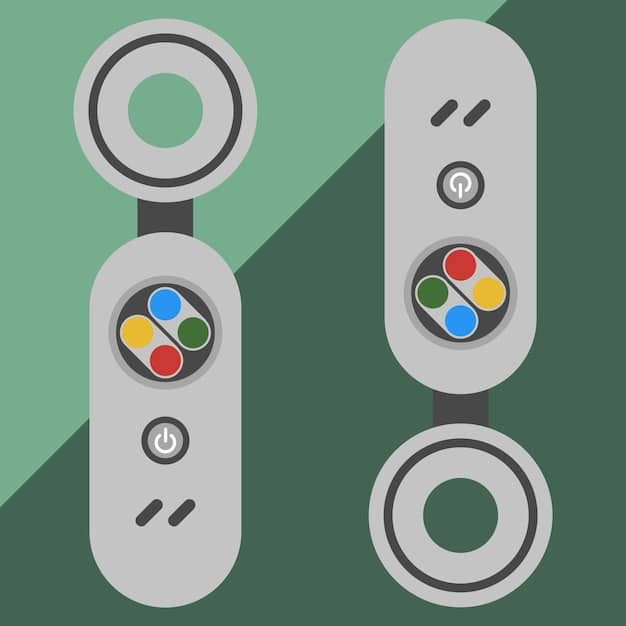The Future of Gaming Keyboards: Mechanical vs Optical Switches

The future of gaming keyboards hinges on the battle between mechanical and optical switches, with each technology offering unique advantages in terms of responsiveness, durability, and customization, shaping the landscape of competitive and casual gaming.
The world of gaming peripherals is constantly evolving, and at the forefront of this innovation is the gaming keyboard. The debate between mechanical vs. optical switches is central to understanding the future of gaming keyboards, with each technology offering distinct advantages for gamers.
Understanding Mechanical Keyboard Switches
Mechanical keyboards have long been a favorite among gamers and typists alike, celebrated for their tactile feedback and durability. Their design and functionality rely on physical switches that activate when a key is pressed, creating a distinct typing experience.
How Mechanical Switches Work
Mechanical switches operate through a physical mechanism beneath each keycap. When you press a key, it depresses a stem that moves a slider, which in turn triggers a metal leaf to make contact, registering the keystroke. This physical process allows for distinct tactile and auditory feedback.
Types of Mechanical Switches
Various types of mechanical switches cater to different preferences. Cherry MX switches, for example, are renowned for their reliability and come in various colors, such as Blue (clicky), Brown (tactile), and Red (linear). Other brands like Gateron and Kailh offer similar options with slight variations in feel and sound.
- Linear Switches: Offer a smooth, consistent keypress without any tactile bump or click.
- Tactile Switches: Provide a noticeable bump when the key is activated, giving users feedback.
- Clicky Switches: Combine tactile feedback with an audible click, popular for those who enjoy a more pronounced typing experience.

Mechanical switches can be customized via lubrication and even the rubber o-rings.
In conclusion, mechanical keyboard switches are based on mechanical feel and various options allowing the keyboard to perform as you wish.
Exploring Optical Keyboard Switches
Optical keyboards represent a more recent advancement in gaming technology. Unlike mechanical keyboards, optical keyboards use light to register keystrokes, offering potentially faster response times and increased durability.
How Optical Switches Work
Optical switches, also known as light switches, use a beam of light and a light sensor to register keystrokes. When a key is pressed, it breaks the light beam, and the sensor detects the interruption, activating the key. This process eliminates the need for physical contact, reducing wear and tear.
Advantages of Optical Switches
Optical switches offer several advantages over mechanical ones. Their faster response times are particularly appealing to gamers who require split-second reactions. Additionally, the lack of physical contact can extend the lifespan of the switches.
- Faster Response Times: Light-based actuation allows for quicker key registration.
- Increased Durability: Fewer moving parts reduce the likelihood of mechanical failure.
- Water Resistance: Some optical keyboards are designed to be more resistant to spills and dust.
In essence, optical keyboard switches use light to trigger the keystroke.
Response Time and Latency
Response time and latency are critical factors for gamers, influencing how quickly actions are registered in-game. The differences in actuation methods between mechanical and optical switches play a significant role in these aspects.
Mechanical Switch Response Time
Mechanical switches have a physical actuation point that requires a certain amount of travel before registering a keystroke. This physical process introduces a slight delay, but the tactile feedback allows greater control.
Optical Switch Response Time
Optical switches use light-based actuation, which eliminates the physical delay associated with mechanical switches. This can, in theory, result in faster response times, providing a competitive edge in fast-paced games.

However, the difference in response time between mechanical and optical is not always perceptible meaning a player would not notice.
In conclusion, the response time difference between the two is not always noticeable but optical can be quicker than mechanical.
Durability and Lifespan
The durability and lifespan of a gaming keyboard are important for both casual and professional gamers. The construction and actuation methods of mechanical and optical switches impact their long-term reliability.
Mechanical Switch Durability
Mechanical switches are known for their robustness, often rated for 50 million or more keystrokes. This lifespan is due to the quality of materials used and the straightforward mechanical design.
Optical Switch Durability
Optical switches typically have an even higher lifespan rating, sometimes exceeding 100 million keystrokes, because of the reduced physical wear and tear due to the optical actuation method. Fewer moving parts translate to less friction and prolonged durability.
- Material Quality: High-quality components contribute to the longevity of mechanical switches.
- Reduced Wear: Optical switches experience less physical degradation over time.
- Environmental Factors: Resistance to dust and spills can further extend the lifespan of optical keyboards.
Overall, both kinds are built to last, but optical switches can have a higher rating due to being activated by light.
Customization and Aesthetics
Customization and aesthetics are vital for many gamers who want their peripherals to reflect their personal style. Both mechanical and optical keyboards offer various options for customization, but in different ways.
Keycap Compatibility
Mechanical keyboards are highly customizable, with a wide range of keycaps available in various materials, profiles, and designs. The standard Cherry MX stem design allows for easy swapping and customization.
RGB Lighting and Aesthetics
Both mechanical and optical keyboards often feature RGB lighting, which can be customized to create various lighting effects and color schemes. The aesthetics of a gaming keyboard can significantly enhance the overall gaming setup, providing an immersive visual experience.
Both are able to be customized to your liking, whether through RGB or various keycaps.
The Future Trends in Gaming Keyboards
As technology advances, several trends are emerging in the gaming keyboard market that promise to enhance the gaming experience further. These trends include advancements in switch technology, wireless capabilities, and ergonomic design.
Advancements in Switch Technology
Manufacturers are continuously innovating to improve switch technology. This includes developing new switch types that offer even faster response times, greater durability, and enhanced tactile feedback.
Wireless Gaming Keyboards
Wireless gaming keyboards are becoming increasingly popular, offering gamers the freedom to move around without being tethered to their PC. Modern wireless technology has also reduced latency to a level comparable to wired keyboards, with some reporting similar responses.
- Improved Latency: Modern wireless technology minimizes input lag.
- Ergonomic Designs: Split keyboards and contoured key layouts promote comfortable hand positions.
- Software Integration: Advanced software allows for extensive customization of lighting and macros.
There will likely be further innovations in the keyboard industry.
| Key Feature | Brief Description |
|---|---|
| 💡 Actuation Method | Mechanical uses physical contact; Optical uses light sensors. |
| ⏱️ Response Time | Optical switches generally offer faster response times than mechanical. |
| 💪 Durability | Both are durable, but optical switches often have higher keystroke ratings. |
| ✨ Customization | Mechanical keyboards offer more keycap and switch customization options. |
FAQ
▼
Mechanical switches use physical contact to register keystrokes, providing tactile feedback. Optical switches use light sensors, offering faster response times and potentially longer lifespans.
▼
Optical keyboards can provide a competitive edge due to their quicker response times. However, whether they are “better” depends on personal preference, as some gamers prefer the tactile feel of mechanical switches.
▼
Mechanical switches are known for their durability, often rated for around 50 million keystrokes. High-quality materials and robust designs contribute to their long lifespan.
▼
Mechanical keyboards offer more customization options. A wide range of keycaps and switches are available, allowing users to tailor their keyboard to their specific preferences and needs.
▼
Yes, modern wireless technology has minimized input lag, making wireless gaming keyboards suitable for competitive gaming. These keyboards give freedom from wired connections while still providing very low latency.
Conclusion
In summary, the future of gaming keyboards is marked by two distinct yet innovative technologies: mechanical and optical switches. Both offer unique advantages and cater to diverse user preferences. As technology continues to evolve, gamers can expect even more advanced features, greater customization options, and wireless capabilities that further enhance the gaming keyboard experience.





